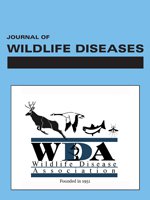Adult vampire bats (Desmodus rotundus) were vaccinated by intramuscular, scarification, oral, or aerosol routes (n=8 in each group) using a vaccinia-rabies glycoprotein recombinant virus. Sera were obtained before and 30 days after vaccination. All animals were then challenged intramuscularly with a lethal dose of rabies virus. Neutralizing antirabies antibodies were measured by rapid fluorescent focus inhibition test (RFFIT). Seroconversion was observed with each of the routes employed, but some aerosol and orally vaccinated animals failed to seroconvert. The highest antibody titers were observed in animals vaccinated by intramuscular and scarification routes. All animals vaccinated by intramuscular, scarification, and oral routes survived the viral challenge, but one of eight vampire bats receiving aerosol vaccination succumbed to the challenge. Of 31 surviving vaccinated and challenged animals, nine lacked detectable antirabies antibodies by RFFIT (five orally and four aerosol immunized animals). In contrast, nine of 10 non-vaccinated control bats succumbed to viral challenge. The surviving control bat had antiviral antibodies 90 days after viral challenge. These results suggest that the recombinant vaccine is an adequate and safe immunogen for bats by all routes tested.
How to translate text using browser tools
1 July 2002
VACCINATION OF VAMPIRE BATS USING RECOMBINANT VACCINIA-RABIES VIRUS
Alvaro Aguilar-Setién,
Yolanda Leon Campos,
Emiliano Tesoro Cruz,
Roberto Kretschmer,
Bernard Brochier,
Paul-Pierre Pastoret

Journal of Wildlife Diseases
Vol. 38 • No. 3
July 2002
Vol. 38 • No. 3
July 2002
rabies
recombinant vaccinia-rabies
vaccination
Vampire Bats




